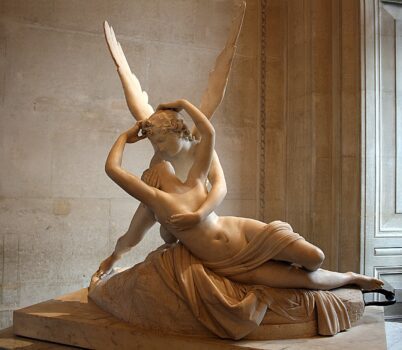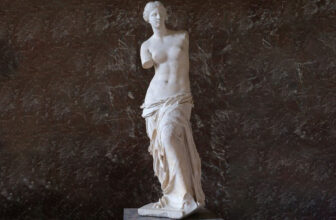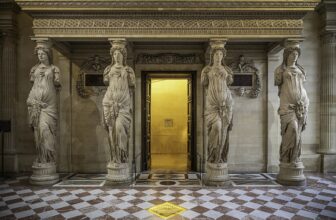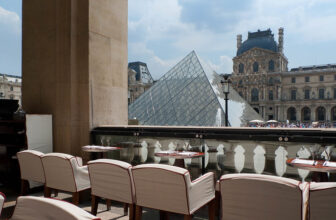Psyche revived by Cupid’s kiss Sculpture
The Myth of Psyche Revived by Cupid’s Kiss
One of the most celebrated depictions of the neoclassical marble sculpture is the Psyche Revived by Cupid’s Kiss by Antonio Canova, completed in 1793. This masterpiece captures the pivotal moment when Cupid revives Psyche with his kiss, breathing life and love back into her after her trials.
Canova sculpted Psyche Revived by Cupid’s Kiss during a period of intense artistic and political change in Europe. The late 18th century was marked by Enlightenment ideals, revolutionary upheavals, and a renewed interest in classical antiquity. Neoclassical artists like Canova sought to embody rational beauty, moral clarity, and emotional restraint, often drawing upon Greco-Roman mythology to explore universal human experiences. In this context, Canova’s Psyche and Cupid represents more than a mythological story, it is a meditation on human emotion, resilience, and the transformative power of love.
Canova’s sculpture is an exquisite example of neoclassical art, emphasizing idealized beauty, harmony, and emotional expression. The work is an evidence to Canova’s technical prowess and his ability to infuse marble with a sense of life and motion.
The composition of the sculpture is dynamic yet balanced. Cupid is depicted as a lithe, youthful figure, gently cradling Psyche, whose body is languid and graceful. His wings are outstretched, suggesting both movement and divine presence. Psyche’s posture, with one arm raised to meet Cupid’s face and the other draped behind her, conveys both vulnerability and yearning. The intertwined figures form an intimate, circular composition that invites viewers to walk around the sculpture, discovering its details from every angle.
Canova’s attention to detail is extraordinary. The texture of the skin, the softness of Psyche’s hair, and the delicate folds of the drapery all contribute to the illusion of living figures frozen in marble. The expression on Psyche’s face, caught between unconsciousness and awakening, is a moment of transcendence, encapsulating the emotional core of the myth.
Psyche Revived by Cupid’s Kiss Artistic Excellence and Technique
Canova’s work is emblematic of the neoclassical movement, which sought to revive the ideals of classical antiquity through harmony, idealized forms, and restrained emotional expression. In Psyche Revived by Cupid’s Kiss, the figures are rendered with a fluid naturalism that belies the hardness of the marble. The dynamic composition, Cupid leaning over Psyche, wings extended, and Psyche’s body curving back in a delicate arch, demonstrates Canova’s understanding of anatomy, balance, and tension. The intertwined figures create a circular, almost spiral motion that guides the viewer’s gaze seamlessly across the sculpture. Every angle offers a new discovery: the subtle flexing of Cupid’s fingers, the gentle lift of Psyche’s arm, the delicate strands of hair cascading down her neck.
The textural contrasts Canova achieves are remarkable. Psyche’s smooth skin contrasts with the soft curls of her hair and the flowing drapery, emphasizing both realism and idealization. The marble captures the ephemeral qualities of breath, warmth, and intimacy, inviting viewers to contemplate not only the narrative moment but also the sculptor’s ability to animate stone. In a sense, Canova creates a dialogue between permanence and transience, the cold solidity of marble embodies a fleeting, tender moment suspended in time.
What is the myth of Psyche revived by Cupid’s kiss?
Exploring the myth of Psyche revived by Cupid’s kiss and the context of the sculpture housed in the Louvre. We’ll break it into a cohesive narrative and discussion.
The Myth of Psyche Revived by Cupid’s Kiss: Love, Trial, and Redemption
The myth of Psyche Revived by Cupid’s Kiss, in Greek mythology originates from the Latin novel The Golden Ass by Apuleius, written in the 2nd century CE. This tale of love and redemption is one of the most enduring love stories in Western mythology, rich with allegory and symbolism.
Psyche, whose name means “soul” or “breath of life,” was a mortal woman of extraordinary beauty. Her beauty was so great that people began to neglect the worship of Venus, Aphrodite in Greek mythology, the goddess of love and beauty, instead paying homage to Psyche. This enraged Venus, who decided to punish Psyche by sending her son Cupid to make her fall in love with a monstrous creature.
Cupid, however, fell in love with Psyche himself when he saw her. He defied his mother’s orders and instead whisked Psyche away to a magnificent palace, where he visited her nightly under the condition that she never look upon his face. Psyche, curious and encouraged by her jealous sisters, eventually broke this rule by lighting a lamp while Cupid slept. Her love turned to despair as a drop of oil from the lamp fell onto Cupid, awakening him. Betrayed by her lack of trust, Cupid fled, and Psyche was left alone.
Determined to win back Cupid’s love, Psyche sought Venus’s aid, who set her on a series of nearly impossible tasks. These trials included sorting an enormous heap of mixed grains, gathering golden wool from fierce sheep, and retrieving water from a treacherous waterfall guarded by dragons. Each task was completed with divine assistance, a testament to Psyche’s determination and purity of spirit.
The final and most perilous task was to descend into the underworld and retrieve a box of beauty ointment from Persephone, the queen of the underworld. Psyche succeeded but, overcome by curiosity, opened the box. Instead of beauty, it contained an infernal sleep that overcame her. At this moment, Cupid intervened. He flew to Psyche, revived her with a kiss, and appealed to Jupiter, Zeus to grant her immortality so they could be united forever. Jupiter consented, and Psyche was made a goddess. The two were married in a divine ceremony, symbolizing the union of love, Cupid and the soul, Psyche, an eternal bond of trust and devotion.
Where to Find Psyche Revived by Cupid’s Kiss in the Louvre
The sculpture resides in the Louvre Museum in Paris, one of the most famous art institutions in the world. Psyche Revived by Cupid’s Kiss is housed in the Department of Sculptures, specifically in the Denon Wing, Room 403, dedicated to works from the Neoclassical and Romantic periods. The sculpture is prominently displayed, allowing visitors to appreciate its intricate details and the emotional depth it conveys.
Visitors to the Louvre often remark on the luminous quality of the marble, which seems to glow under the museum’s lighting. The interplay of light and shadow across the sculpture’s surface enhances the sense of life and motion, drawing viewers into the tender moment between Cupid and Psyche.
Psyche Revived by Cupid’s Kiss Symbolism and Legacy
The myth of Psyche and Cupid, as well as Canova’s depiction, continues to resonate because it speaks to universal themes: the trials of love, the necessity of trust, and the redemptive power of forgiveness. Psyche’s journey from mortal woman to immortal goddess represents the soul’s progression through suffering and growth, ultimately finding unity with love.
Canova’s Psyche Revived by Cupid’s Kiss has influenced countless artists and remains a cornerstone of discussions about neoclassical art. It is not merely a depiction of a myth but a profound exploration of human emotion, rendered in the timeless medium of marble.
The work’s placement in the Louvre ensures its accessibility to millions of visitors each year, who continue to be captivated by its beauty and the story it represents. The sculpture serves as a reminder of art’s power to bridge the gap between ancient myths and contemporary audiences, making the themes of love and perseverance as relevant today as they were in antiquity.
In modern interpretations, Psyche Revived by Cupid’s Kiss’s story has been examined through psychological and philosophical lenses. Carl Jung viewed Psyche as an archetype of the human soul’s journey toward self-realization, with Cupid representing the transformative power of love and integration of the psyche. The sculpture, therefore, is not only a visual delight but also a profound meditation on the intersection of human experience, emotional resilience, and spiritual growth.
Cultural Reflections
The enduring popularity of Psyche and Cupid’s myth can be seen in literature, art, and psychology. The story has been interpreted as an allegory for the union of mind and soul, the tension between physical desire and spiritual love, and the trials one must endure for true intimacy.
In psychological terms, Carl Jung regarded Psyche as an archetype of the human soul’s journey toward individuation, a process of integrating the conscious and unconscious parts of the self. Cupid’s role as a divine lover who rescues and transforms Psyche mirrors the transformative power of love in personal growth.
The sculpture itself, beyond its mythological subject, represents an ideal of neoclassical aesthetics: the pursuit of harmony, emotional clarity, and a celebration of human potential. In an age marked by revolutions and upheaval, Canova’s work offered a vision of transcendence and enduring beauty.
The myth of Psyche revived by Cupid’s kiss is a timeless tale that continues to inspire through its themes of love, trust, and redemption. Antonio Canova’s sculpture at the Louvre captures the essence of this story in a way that is both emotionally stirring and artistically unparalleled. To stand before this masterpiece is to witness not only the triumph of artistic skill but also the enduring power of myth to connect us with the deeper truths of human existence. Whether as a story, an artwork, or an allegory, Psyche and Cupid’s tale reminds us of the profound interplay between love and the soul, a bond that transcends time and mortality.




